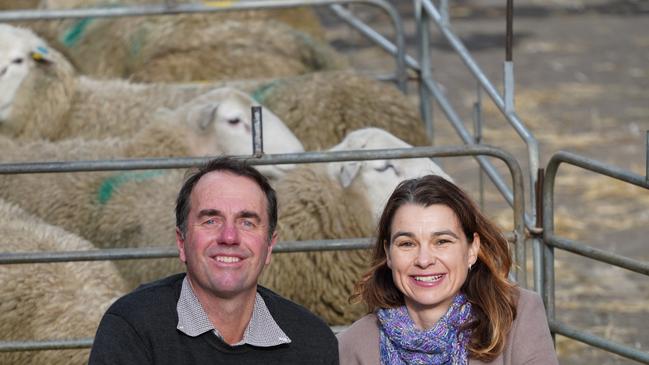One of Australia’s biggest ram breeders moves to sheep that shed wool, cutting out shearers
Shearers could be a thing of the past — if an increasingly popular breed of sheep becomes mainstream.

In the far west of Victoria, where sheep have grazed since the early 1840s when squatters drove their flocks in, wool has been a core and often handsomely rewarding farm commodity.
While Australia once rode on the sheep’s back, the Golden Fleece of the Merino has now been replaced in many high rainfall areas with the more environmentally suited crossbreds, and more recently, composites.
While composites produce a hefty carcass, growing fast and reproducing many lambs, their wool is nothing to write home about.
In fact, for an increasing number of crossbred and composite producers, who are tightly focused on meat production, broad wools have become an unwanted annoyance.
And, a costly one to harvest.
Back in 2003 John Keiller, a well known breeder of terminal sheep and maternal composites from Cashmore Park near Portland, one of Australia’s highest rainfall districts, started breeding performance recorded shedding sheep.
From day one, John said he and wife Brigita had a strong focus on the carcass attributes of the shedding sheep, which they would dubbed “Cashmore Nudies” and on improving their reproduction and fertility.
“We rounded up some shedding sheep; Dorpers, Wiltshire Horn and Wiltipolls,” he said.
Once the sheep were bred to a level “comparable to our maternal composites we put the animals into the maternal composite database and now what we have is a very high performance flock”, John said, where maternal composites are infused to boost the Nudies genetics.
“We could see that long-term these sheep would be needed for the reasons we are facing now; and they are becoming more and more relevant,” he said.
“The economics are right in the position that people are questioning whether they are right for them.”
John said those reasons were strong commodity prices for meat and poor returns on broad micron crossbred wool, along with shearing labour costs and shortages made shedding sheep attractive for a wide cross-section of producers.
Now, the profitability of shedding sheep, compared to a maternal composite flock, was neck-and-neck. John said an analysis by agricultural consultancy Meridian found the two enterprises were typically “very comparable, there is not much in it”.
“There was a slight decrease in the gross income (from a Nudie flock) but a large change in the costs.
“We keep asking questions of what we do and why we do it, we are trying to see where we think the future might be.”
Last week Cashmore Park teamed up with Meridian to host a field day attended by around 140 producers to hear about the reality of running shedding sheep. Ironically it was held in Hamilton - formerly known as the “wool capital of the world” due to the high numbers of Merino sheep run in the region.
While shedding sheep are still well in the minority in the region, there is growing interest in them.
John said the shedding sheep still grow a layer of protective wool for the colder months, shedding gradually from spring to early summer and then regrowing a fleece by early April.
The fleece was much lighter than conventional breeds of sheep run on Australian farms, weighing more like 1kg compared to 5kgs.
“It is biodegradable of course so there is no issue with it in the paddocks,” he said.
In fact, the nutrient cycling could even be beneficial for the soil, he said.
“Shedding is a big psychological step for traditional sheep producers who think if you have sheep you have wool, but a lot of sheep around the world do not have big fleeces,” he said.
“It is market forces, the dollar wins in the end, so people will make decisions going forward on that.”
Now Cashmore Oaklea – the combined studs of Cashmore Park and Don Pegler’s Oaklea – sell 1300 composite rams per year and Cashmore is selling 150 Nudie rams.
The Nudie rams are sold to farms as far and wide as Kangaroo Island, South East South Australia and Southern NSW and Tasmania and to everyone from large to small scale farmers.
“They go to wherever people are looking for shedding, easy-care sheep with performance data,” he said.
Typically, the Nudies weighed in at 65kg for a mature ewe, marking 150 per cent lambs and running at stocking rates comparable to maternal composites.
John said the stud was continuing to work on increasing growth rates and reproductive attributes. “Reproduction has been a bit of a flat patch with the easy care sheep, but we are improving that, they just didn’t have the years of history behind them.”
On the flip side, the Nudie were more resistant to parasites and had good foot structure.
Cashmore has also left tails on some Nudies to learn if they could be managed that way.
“We’ve found no issues and they stay remarkably clean (of dags) and in summer, it is very clear to see they use their tails very well to prevent flies, there does not seem to be any downside,” he said.
“It is what we do, we keep questioning why do we do things this way.”
For now, the shearer still has plenty of sheep in front of them. But, if Nudies get their way, their workload will get that bit lighter.
MORE
$1B LIFT IN SALES OF STOCK ONLINE IN COVID


